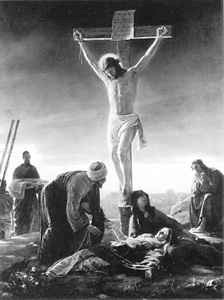
The Cross |

The Crucifixion, by Carl Heinrich Bloch (1834-1890, oil on copper plate; 20" x 30"). The Savior Jesus Christ is crucified on Calvary, offering himself as a sacrifice for mankind. Courtesy the Frederiksborg Museum, Hillerod, Denmark.
by Roger R. Keller
Also see The Symbol of Christ by Elder Gordon B. Hinckley. In this article Elder Hinckley explains why Latter-day Saints do not use the cross as a symbol of their worship.
The cross, a traditional symbol of Christianity, is displayed extensively in Catholicism, Eastern Orthodoxy, and Protestantism. In each tradition, the symbol of the cross focuses the worshiper's attention on central elements of the Christian faith. However, different theological points may be emphasized. For example, in Catholicism the crucifix (the cross with the dead Christ hanging on it) symbolizes the crucifixion of Christ and invites meditation on the Atonement. In contrast, the plain cross used by Protestants symbolizes not only the crucifixion but also the resurrection of Christ, for the cross is empty. The Eastern Orthodox crucifix is a symbolic concept somewhere between those of Catholicism and Protestantism: Christ hangs on the cross, but as the living Lord, his head not bowed in death but raised in triumph. Thus, the crucifixion, the Atonement, the resurrection, and the Lordship of Christ are all graphically presented in the Orthodox crucifix. (See Interfaith Relations home page)
Latter-day Saints do not use the symbol of the cross in their architecture or in their chapels. They, like the earliest Christians, are reluctant to display the cross because they view the "good news" of the gospel as Christ's resurrection more than his crucifixion.
The LDS conception of the Plan of Salvation is comprehensive. It encompasses a Council in Heaven; Jehovah's (Jesus') acceptance of his role as Savior; the virgin birth; Jesus' life and ministry; his saving suffering, beginning in Gethsemane and ending with his death at Golgotha; his burial; his preaching to the spirits of the righteous dead; his physical resurrection; and his exaltation to the right hand of the Father. No one symbol is sufficient to convey all this. Moreover, the cross, with its focus on the death of Christ, does not symbolize the message of a living, risen, exalted Lord who changes the lives of his followers. Thus, President Gordon B. Hinckley, counselor in the First Presidency, stated that the lives of people must become a "meaningful expression of our faith and, in fact, therefore, the symbol of our worship" (p. 92). (See Taking the Name of Christ)
While the symbol of the cross is not visually displayed among the Latter-day Saints, the centrality of the Atonement is ever present in their observance of baptism, the Sacrament of the Lord's Supper (see Sacrament Prayers), and the temple ordinances, and in their hymns and testimonies. Without the Atonement of Jesus Christ, there is no hope for the human family. Scripture is replete with the admonition that disciples of Christ must "take up their cross," yielding themselves in humility to their Heavenly Father (D&C 56:2, 14-16; 112:14-15), releasing themselves from the ties of worldliness (3 Ne. 12:20), and submitting themselves to persecution and even martyrdom for the gospel of Jesus Christ (2 Ne. 9:18; Jacob 1:8).
(See Basic Beliefs home page; Teachings About Jesus Christ home page; Easter home page)
Bibliography
Hinckley, Gordon B. "The Symbol of Christ." Ensign 5 (May 1975):92-94.
Pocknee, Cyril E. Cross and Crucifix. London, 1962.
Encyclopedia of Mormonism, Vol. 1, Cross
Copyright © 1992 by Macmillan Publishing Company
All About Mormons |